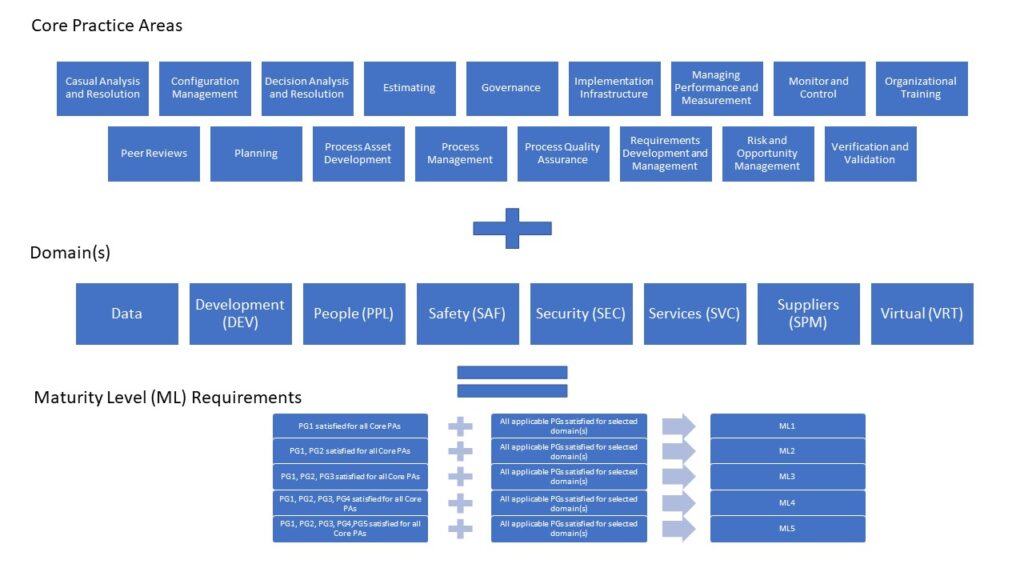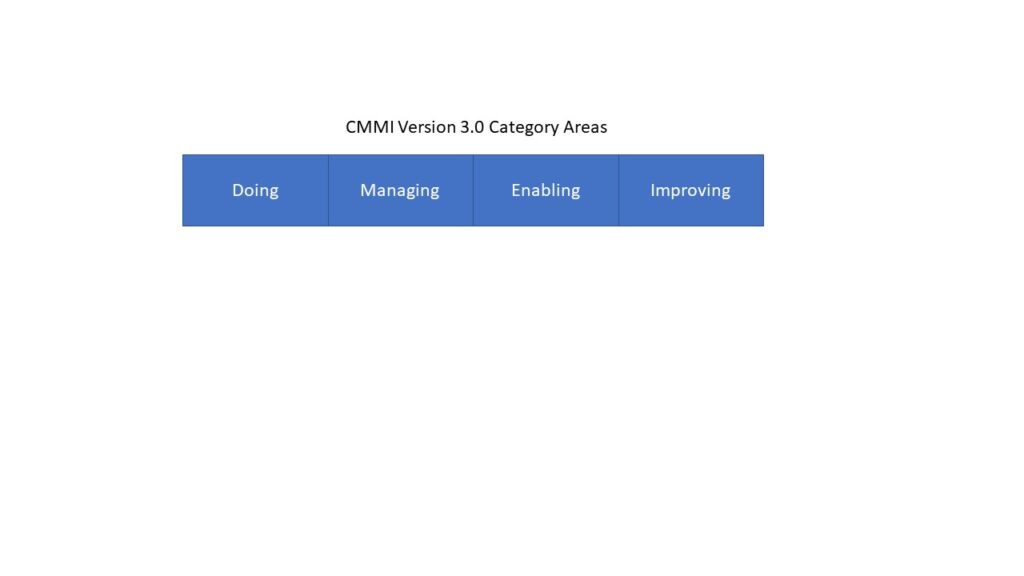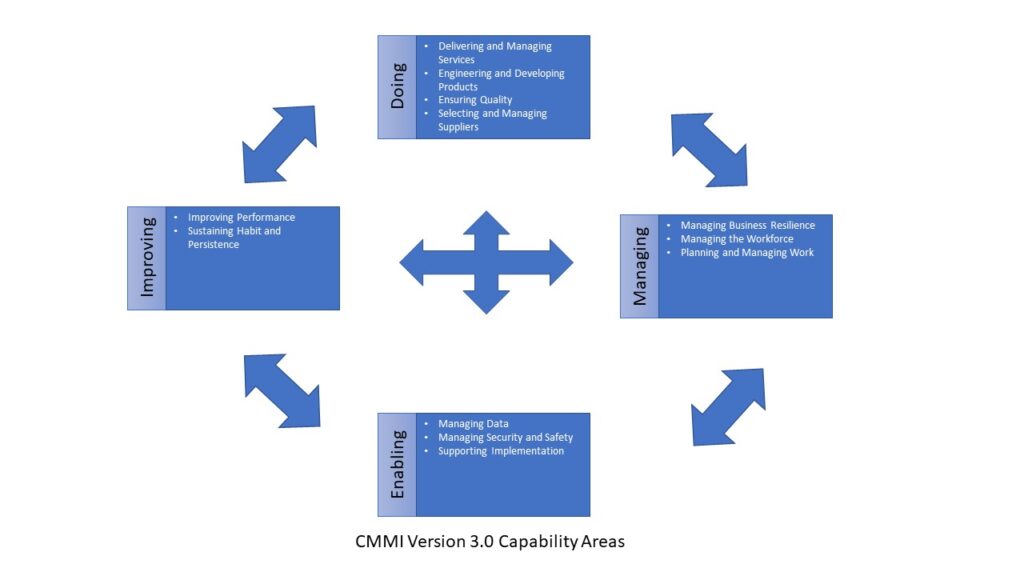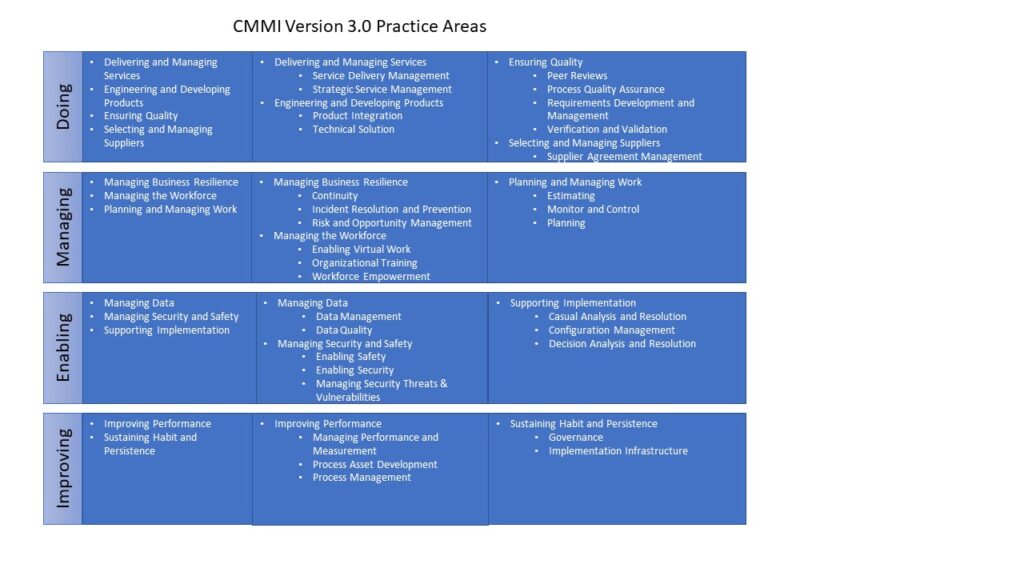The newly released CMMI v3.0 presents some strategic changes and improvements in both methodology and approach. These updates provide the addition of new requirements, an evolution of historical standards, as well as a continuation of familiar practices.
Contents
The new CMMI v3.0 and the changes from CMMI v2.0?
CMMI v3 is defined to highlight critical capabilities common within companies, with an attention to performance practices and a focus on process improvement through repeatability and practice. CMMI global best practices enable organizations to build and benchmark the most common business challenges including:
- Manage Work, Ensure Quality & Improve Performance
- Develop Products & Deliver / Manage Services
- Manage Suppliers
- Manage Workforce & Support Implementation
- Sustain Habit Persistence & Manage Business Resilience
- Manage Data, Security & Safety
New CMMI v3.0 Release Date
The CMMI Institute, on April 6, 2023, released its newest version of the CMMI model, the CMMI v3.
CMMI v3.0 Transition Date
CMMI V2.2 will be sunset on June 2024. Beginning January 1, 2024, only CMMI V3.0 appraisals will be accepted. The changes in version 3.0 of CMMI may not be substantial enough to justify a shift in direction for most organizations aiming for a V2.2 appraisal, especially for users focusing on CMMI for Development or Services, as the differences are not significant.
Looking to upgrade in CMMI V3.0?
If you already have a CMMI v2.2 you will have to upgrade to CMMI v3.0. ITG’s CMMI Consultants can guide you to a successful upgrade or to a new CMMI Implementation.
CMMI V3.0 Changes
In this latest update, the CMMI Performance Solutions ecosystem undergoes a series of minor yet significant improvements. The focus has been on enhancing various aspects, including grammar, formatting, plain language, translatability, clarity, and consistency with the CMMI Style Guide and ecosystem guidelines. Notably, all references to V2.0 have been updated appropriately, and the CMMI Product Suite has been renamed to the CMMI Performance Solutions ecosystem.
Removal of Supplier Source Selection SSS
A notable change involves the removal of the Practice Area: Supplier Source Selection (SSS). However, its essential content was extracted and incorporated into the Supplier Agreement Management (SAM) Practice Area for better organization and accessibility.
Addition of Managing Data
Additionally, a new Capability Area has been introduced: Managing Data, acknowledging the growing significance of data management. Alongside this addition, three new Practice Areas are included: Data Management (DM), Data Quality (DQ), and Workforce Empowerment (WE).
The former Practice Area, Enabling Virtual Solution Delivery (EVSD), was renamed to Enabling Virtual Work (EVW) to better reflect its scope, considering virtual work in addition to virtual delivery based on community feedback.
The update also encompasses the alignment of view/domain information with the following domains: Data, Development, People, Safety, Security, Services, Suppliers, and Virtual. Notably, the Supplier Management view was renamed to Suppliers for better clarity.
CMMI V3.0 has updated also Context Specific Information:
- Addition of Context Specific information for Data, DevSecOps, and People across core and domain Practice Areas
- Agile with Scrum Guidance Context Specific information renamed to Agile Development, and all content updated for clarity
- Supplier Management Context Specific information renamed to Suppliers for consistency with Suppliers domain
Under the latest release of CMMI Version 3.0, organizations can benefit from the continuity of familiar terminology. Unlike the previous CMMI Version 2.0 Model, which introduced new terminology and redefined the grouping of requirements into Category Areas, Capability Areas, and Practice Areas, CMMI Version 3.0 maintains consistent terminology, facilitating a smoother transition and ensuring continuity for organizations familiar with previous versions.
CMMI V3.0 Model
The new CMMI V3.0 Model has four (4) Category Areas, twelve (12) CMMI V2 Capability Areas and thirty-one (31) Practice Areas

CMMI v3.0 Category Areas
There are four (4) CMMI Category Areas, that are groups of related areas that define practices for improved performance within the defined activities for an organization or project.

CMMI v3.0 Capability Areas
Each Category Area contains specifically defined Capability Areas, which are logical groups of related and common practices that organizations typically encounter with developing and delivering a product and/or service.

CMMI V3.0 Maturity Levels
CMMI Maturity Level 1 (ML1) Initial
In CMMI ML1 organizations meet the intent of Practice Area(s), but practices are not fully implemented and usually are reactive in addressing issues.
CMMI Maturity Level 2 (ML2) Managed
In CMMI Level 2 organizations implement practices to meet the intent of Practice Area(s), proactively address issues and achieve program objectives. ML2 does not require use of organizational assets.
CMMI Maturity Level 3 (ML3) Defined
In CMMI ML3 there is use of organizational standard practices, assets, and tailoring that address issues, achieve organization objectives, program objectives and focus on overall quality. The following Practice Areas are rated at Maturity Level 3 (Configuration Management does not have any additional practices at Maturity Level 3)
CMMI Core Practice Areas:
- Managing Performance and Management
- Process Quality Assurance
- Configuration Management
- Monitor and Control
- Planning
- Estimating
- Requirements Development and Management
- Governance
- Implementation Infrastructure
- Causal Analysis and Resolution
- Decision Analysis and Resolution
- Organizational Training
- Risk and Opportunity Management
- Process Asset Development
- Peer Reviews
- Process Management
- Verification and Validation
Domains Specific:
- Development:
- Technical Solution
- Product Integration
- Data:
- Data Management
- Data Quality
- People:
- Workforce Empowerment
- Safety:
- Enabling Safety
- Security:
- Enabling Security
- Managing Security Threats & Vulnerabilities
- Services:
- Continuity
- Incident Resolution & Prevention
- Service Delivery Management
- Strategic Service Management
- Suppliers:
- Supplier Agreement Management
- Virtual:
- Enabling Virtual Work
CMMI Maturity Level 4 (ML4) Quantitively Managed
For the upgrade in CMMI ML4 organizations must have controlled processes, measured with the use of statistical and quantitative techniques and prediction tools for achieving quality, performance, and objectives. The following Practice Areas are rated at Maturity Level 4, in addition to everything above:
- Managing Performance and Management
- Planning
- Governance
- Implementation Infrastructure
- Causal Analysis and Resolution
- Process Management
- Supplier Agreement Management (Suppliers Domain)
- Managing Security Threats and Vulnerabilities (Security Domain)
CMMI Maturity Level 5 (ML5) Optimizing
Finally, in order to reach CMMI ML5 needs to optimize process improvement through use of statistical and quantitative techniques. The following Practice Areas are rated at Maturity Level 5, in addition to everything above
- Managing Performance and Management
- Causal Analysis and Resolution
CMMI v3.0 Practice Areas
Primary in CMMI Version 3.0 there are thirty-one (31) applicable Practice Areas. Key changes between V2.2 and V3.0 are the additions of new Practice Areas (Data Management (DM), Data Quality (DQ), Workforce Empowerment (WE)), the removal of the Supplier Source Selection (SSS) Practice Area, from which context was extracted and incorporated into the Supplier Agreement Management (SAM) Practice Area. Lastly another change to observe is the new name for the Enabling Virtual Solution Delivery (EVSD) to Enabling Virtual Work (EVW).

